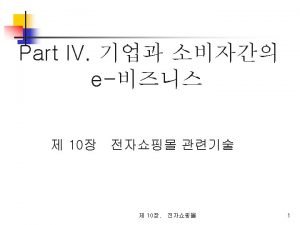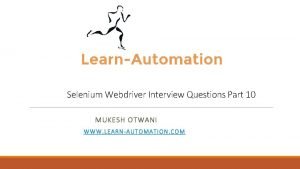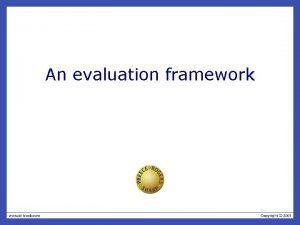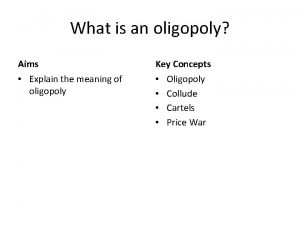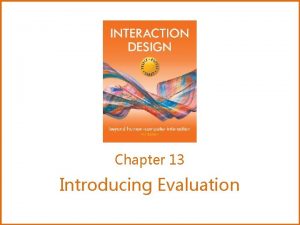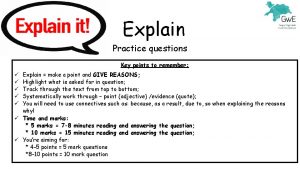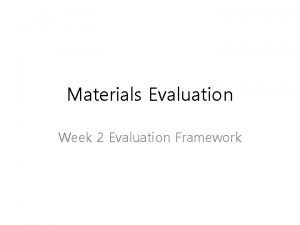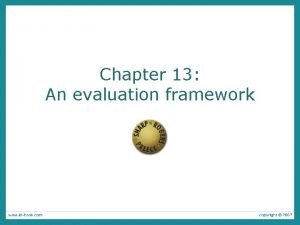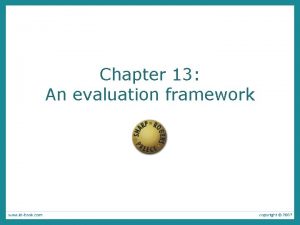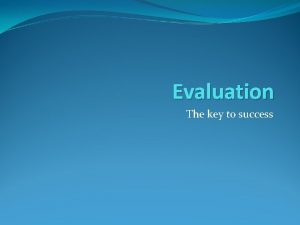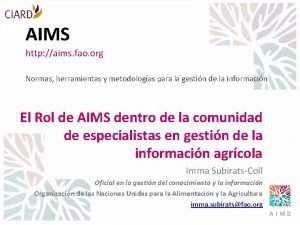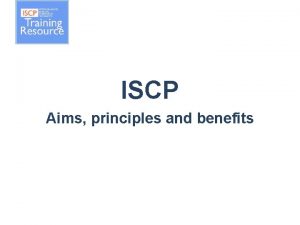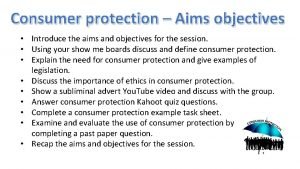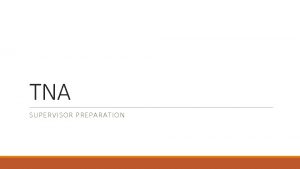An evaluation framework The aims Explain key evaluation
































- Slides: 32

An evaluation framework

The aims · Explain key evaluation concepts & terms. · Describe the evaluation paradigms & techniques used in interaction design. · Discuss the conceptual, practical and ethical issues that must be considered when planning evaluations. · Introduce the DECIDE framework.

Evaluation paradigm Any kind of evaluation is guided explicitly or implicitly by a set of beliefs, which are often under-pined by theory. These beliefs and the methods associated with them are known as an ‘evaluation paradigm’

User studies involve looking at how people behave in their natural environments, or in the laboratory, both with old technologies and with new ones.

Four evaluation paradigms • • ‘quick and dirty’ usability testing field studies predictive evaluation

Quick and dirty • ‘quick & dirty’ evaluation describes the common practice in which designers informally get feedback from users or consultants to confirm that their ideas are in-line with users’ needs and are liked. • Quick & dirty evaluations are done any time. • The emphasis is on fast input to the design process rather than carefully documented findings.

Usability testing • Usability testing involves recording typical users’ performance on typical tasks in controlled settings. Field observations may also be used. • As the users perform these tasks they are watched & recorded on video & their key presses are logged. • This data is used to calculate performance times, identify errors & help explain why the users did what they did. • User satisfaction questionnaires & interviews are used to elicit users’ opinions.

Field studies • Field studies are done in natural settings • The aim is to understand what users do naturally and how technology impacts them. • In product design field studies can be used to: - identify opportunities for new technology - determine design requirements - decide how best to introduce new technology - evaluate technology in use.

Predictive evaluation • Experts apply their knowledge of typical users, often guided by heuristics, to predict usability problems. • Another approach involves theoretically based models. • A key feature of predictive evaluation is that users need not be present • Relatively quick & inexpensive

Overview of techniques · observing users, · asking users’ their opinions, · asking experts’ their opinions, · testing users’ performance · modeling users’ task performance

DECIDE: A framework to guide evaluation • Determine the goals the evaluation addresses. • Explore the specific questions to be answered. • Choose the evaluation paradigm and techniques to answer the questions. • Identify the practical issues. • Decide how to deal with the ethical issues. • Evaluate, interpret and present the data.

Determine the goals • What are the high-level goals of the evaluation? • Who wants it and why? • The goals influence the paradigm for the study • Some examples of goals: - Identify the best metaphor on which to base the design. Check to ensure that the final interface is consistent. Investigate how technology affects working practices. Improve the usability of an existing product.

Explore the questions • All evaluations need goals & questions to guide them so time is not wasted on ill-defined studies. • For example, the goal of finding out why many customers prefer to purchase paper airline tickets rather than e-tickets can be broken down into subquestions: - What are customers’ attitudes to these new tickets? - Are they concerned about security? - Is the interface for obtaining them poor? • What questions might you ask about the design of a cell phone?

Choose the evaluation paradigm & techniques • The evaluation paradigm strongly influences the techniques used, how data is analyzed and presented. • E. g. field studies do not involve testing or modeling

Identify practical issues For example, how to: • select users • stay on budget • staying on schedule • find evaluators • select equipment

Decide on ethical issues • Develop an informed consent form • Participants have a right to: - know the goals of the study - what will happen to the findings - privacy of personal information - not to be quoted without their agreement - leave when they wish - be treated politely

Evaluate, interpret & present data • How data is analyzed & presented depends on the paradigm and techniques used. • The following also need to be considered: - Reliability: can the study be replicated? - Validity: is it measuring what you thought? - Biases: is the process creating biases? - Scope: can the findings be generalized? - Ecological validity: is the environment of the study influencing it - e. g. Hawthorn effect

Pilot studies • A small trial run of the main study. • The aim is to make sure your plan is viable. • Pilot studies check: - that you can conduct the procedure - that interview scripts, questionnaires, experiments, etc. work appropriately • It’s worth doing several to iron out problems before doing the main study. • Ask colleagues if you can’t spare real users.

Key points · An evaluation paradigm is an approach that is influenced by particular theories and philosophies. · Five categories of techniques were identified: observing users, asking experts, user testing, modeling users. · The DECIDE framework has six parts: - Determine the overall goals - Explore the questions that satisfy the goals - Choose the paradigm and techniques - Identify the practical issues - Decide on the ethical issues - Evaluate ways to analyze & present data · Do a pilot study

Observing users

The aims · Discuss the benefits & challenges of different types of observation. · Describe how to observe as an on-looker, a participant, & an ethnographer. · Discuss how to collect, analyze & present observational data. · Examine think-aloud, diary studies & logging. · Provide you with experience in doing observation and critiquing observation studies.

What and when to observe • Goals & questions determine the paradigms and techniques used. • Observation is valuable any time during design. • Quick & dirty observations early in design • Observation can be done in the field (i. e. , field studies) and in controlled environments (i. e. , usability studies) • Observers can be: - outsiders looking on - participants, i. e. , participant observers - ethnographers

Frameworks to guide observation • - The person. Who? - The place. Where? - The thing. What? • The Goetz and Le. Compte (1984) framework: - Who is present? - What is their role? - What is happening? - When does the activity occur? - Where is it happening? - Why is it happening? - How is the activity organized?

The Robinson (1993) framework • • Space. What is the physical space like? Actors. Who is involved? Activities. What are they doing? Objects. What objects are present? Acts. What are individuals doing? Events. What kind of event is it? Goals. What do they to accomplish? Feelings. What is the mood of the group and of individuals?

You need to consider • • • Goals & questions Which framework & techniques How to collect data Which equipment to use How to gain acceptance How to handle sensitive issues Whether and how to involve informants How to analyze the data Whether to triangulate

Observing as an outsider • • As in usability testing More objective than participant observation In usability lab equipment is in place Recording is continuous Analysis & observation almost simultaneous Care needed to avoid drowning in data Analysis can be coarse or fine grained Video clips can be powerful for telling story

Participant observation & ethnography • Debate about differences • Participant observation is key component of ethnography • Must get co-operation of people observed • Informants are useful • Data analysis is continuous • Interpretivist technique • Questions get refined as understanding grows • Reports usually contain examples

Data collection techniques • • Notes & still camera Audio & still camera Video Tracking users: - diaries - interaction logging

Data analysis 1. Qualitative data - interpreted & used to tell the ‘story’ about what was observed. 2. Qualitative data - categorized using techniques such as content analysis. 3. Quantitative data - collected from interaction & video logs. Presented as values, tables, charts, graphs and treated statistically.

Interpretive data analysis · · · · Look for key events that drive the group’s activity Look for patterns of behavior Test data sources against each other - triangulate Report findings in a convincing and honest way Produce ‘rich’ or ‘thick descriptions’ Include quotes, pictures, and anecdotes Software tools can be useful e. g. , NUDIST, Ethnograph (see URL resource list for examples)

Looking for patterns • • Critical incident analysis Content analysis Discourse analysis Quantitative analysis - i. e. , statistics

Key points · Observe from outside or as a participant · Analyzing video and data logs can be timeconsuming. · In participant observation collections of comments, incidents, and artifacts are made. Ethnography is a philosophy with a set of techniques that include participant observation and interviews. · Ethnographers immerse themselves in the culture that they study.
 Defects of secondary education by mudaliar commission
Defects of secondary education by mudaliar commission Business model
Business model Business model canvas tripadvisor
Business model canvas tripadvisor Iot conceptual framework diagram
Iot conceptual framework diagram Application framework in android architecture
Application framework in android architecture Theoritical framework example
Theoritical framework example Electric commerce
Electric commerce Bdd interview questions
Bdd interview questions Dispositional framework vs regulatory framework
Dispositional framework vs regulatory framework Iso/iec/ieee 42010
Iso/iec/ieee 42010 Conceptual framework theoretical framework
Conceptual framework theoretical framework Dispositional framework vs regulatory framework
Dispositional framework vs regulatory framework Conceptual framework vs theoretical framework
Conceptual framework vs theoretical framework Hát kết hợp bộ gõ cơ thể
Hát kết hợp bộ gõ cơ thể Slidetodoc
Slidetodoc Bổ thể
Bổ thể Tỉ lệ cơ thể trẻ em
Tỉ lệ cơ thể trẻ em Chó sói
Chó sói Tư thế worm breton
Tư thế worm breton Bài hát chúa yêu trần thế alleluia
Bài hát chúa yêu trần thế alleluia Môn thể thao bắt đầu bằng chữ f
Môn thể thao bắt đầu bằng chữ f Thế nào là hệ số cao nhất
Thế nào là hệ số cao nhất Các châu lục và đại dương trên thế giới
Các châu lục và đại dương trên thế giới Công của trọng lực
Công của trọng lực Trời xanh đây là của chúng ta thể thơ
Trời xanh đây là của chúng ta thể thơ Cách giải mật thư tọa độ
Cách giải mật thư tọa độ Phép trừ bù
Phép trừ bù Phản ứng thế ankan
Phản ứng thế ankan Các châu lục và đại dương trên thế giới
Các châu lục và đại dương trên thế giới Thơ thất ngôn tứ tuyệt đường luật
Thơ thất ngôn tứ tuyệt đường luật Quá trình desamine hóa có thể tạo ra
Quá trình desamine hóa có thể tạo ra Một số thể thơ truyền thống
Một số thể thơ truyền thống Bàn tay mà dây bẩn
Bàn tay mà dây bẩn






